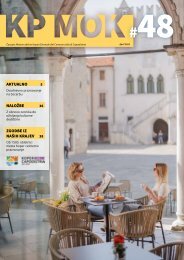EUSAIR - Final Report
You also want an ePaper? Increase the reach of your titles
YUMPU automatically turns print PDFs into web optimized ePapers that Google loves.
»When I arrive<br />
at work in the<br />
morning, I'm<br />
thrilled by<br />
a kingfisher«<br />
Interview with Klavdij Godnič,<br />
director of SOLINE Pridelava soli d. o. o.<br />
Active salt pans are an example of coexistence<br />
between economic activity, tourism and the needs<br />
of nature conservation. What risk does intense<br />
climate change pose for this coexistence?<br />
Climate change poses an increasing risk both to salt<br />
production and to the landscape park itself: if we can<br />
no longer produce salt, we will also endanger all plants<br />
and animals that live here.<br />
The first challenge is the rise in the sea level. High and low<br />
tides are higher, and the entire system of the Sečovlje salt<br />
pans is a closed system. In the event of rain, all rainwater<br />
retained in the landscape park is released on a free-fall<br />
basis. However, because the tides are getting higher, the<br />
water drop is smaller or, put another way, less water flows<br />
out of the closed system in the same period of time. The<br />
quantities of fresh water are not changing during the year<br />
compared to the past; what we observe is that it is raining<br />
more intensely. This extends the number of days it takes<br />
to drain all the water from the system.<br />
The salt pans are dry for up to five days longer. During<br />
this time, damage to salt fields and freshwater plants can<br />
occur. As a result, salt extraction is more difficult, and<br />
the picture of the entire landscape park is also changing.<br />
Did climate changes play a key role in the last<br />
few poor salt harvests? Can you even combat<br />
them at the micro-local level? What does sea<br />
level rise mean for salt pans?<br />
Salt production periods are shorter. In the last ten<br />
years, we have produced an average of 2,000 tons<br />
of salt per year, in 2013, when the harvest was exceptional,<br />
even 5,000 tons of salt. The year before last we<br />
had already dropped to 1,200 tons, and last year we<br />
produced only 800 tons of salt.<br />
We are not accepting new customers this year. If we<br />
record two or three more bad harvests, it will be difficult<br />
to offer it to the market. Some brands are very dependent<br />
on us, since they use our logo on their products.<br />
In the event that we are unable to supply them with<br />
salt, they will be forced to change the entire production<br />
process. Such as Lokev prosciutto factory, Kodila,<br />
Ljubljanske mlekarne ... We are already supplying<br />
limited quantities of salt to larger retail chains.<br />
The state, which last year adopted an ambitious plan<br />
to protect the landscape park with its hinterland, is of<br />
great help to us. The frontal embankments, both banks<br />
<strong>Final</strong> <strong>Report</strong> | 21

















